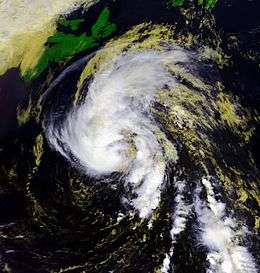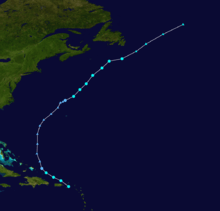Tropical Storm Dean (2001)
| Tropical storm (SSHWS/NWS) | |
 Dean near peak intensity | |
| Formed | August 22, 2001 |
|---|---|
| Dissipated | August 28, 2001 |
| Highest winds |
1-minute sustained: 70 mph (110 km/h) |
| Lowest pressure | 994 mbar (hPa); 29.35 inHg |
| Fatalities | None |
| Damage | $7.7 million (2001 USD) |
| Areas affected | Lesser Antilles, Virgin Islands, Puerto Rico, Bahamas, Bermuda, Canada |
| Part of the 2001 Atlantic hurricane season | |
Tropical Storm Dean was a strong tropical storm that affected at least twelve islands along its path from the tropical Atlantic Ocean to east of Atlantic Canada in August 2001. Dean developed from a tropical wave on August 22 over the Lesser Antilles, and was initially predicted to intensify further to reach hurricane status. However, strong wind shear quickly weakened Dean to cause it to dissipate on August 23. The remnants turned northward, and redeveloped on August 26 to the north of Bermuda. Located over warm waters and in an area of favorable conditions, Dean steadily strengthened while moving to the northeast, and peaked just below hurricane status on August 27 about 465 miles (750 km) southwest of Newfoundland. The storm subsequently weakened over cooler waters, and became extratropical on August 28.
The precursor tropical wave dropped heavy rainfall and produced moderate winds throughout the Lesser Antilles, though no serious damage was reported. In Puerto Rico, rainfall of up to 12.7 inches (322 mm) produced widespread flooding across the island. Thousands were left without power or water, and two houses lost their roofs from the storm. The passage of Dean resulted in $7.7 million (2001 USD, $9.4 million 2008 USD) in damage in Puerto Rico. The storm produced light to moderate rainfall in Bermuda and later in Newfoundland, though no damage was reported.
Meteorological history

A large tropical wave with minimal convection moved off the coast of Africa near Dakar between August 14 and August 15. It moved westward, and gradually developed thunderstorms across the wave axis.[1] On August 21, while located about 450 miles (725 km) east of the Lesser Antilles, convection increased further within the system, though unfavorable upper-level wind shear prevented rapid development.[2] It continued to become better organized, and though a Reconnaissance flight into the system reported strong winds, it lacked a surface circulation. Late on August 21 the wave passed through the northern Lesser Antilles,[1] and subsequent to a decrease in wind shear the system became much better organized on August 22.[3] A surface circulation formed, and the system developed into Tropical Storm Dean on August 22 near Saint Croix. Dean was upgraded directly to a tropical storm due to the presence of 50 mph (80 km/h) winds in the storm.[1]
Reconnaissance Aircraft and surface reports confirmed the existence of a circulation. Dean moved northwestward at 22 mph (35 km/h), under the influence of the Bermuda High to its northeast. The storm strengthened slightly to reach winds of 60 mph (95 km/h) later on August 22, though the circulation was exposed on the western edge of the convection due to the storm's quick forward motion and persistent wind shear. Initial forecasts predicted the shear to decrease, allowing Dean to attain hurricane status with winds of over 80 mph (130 km/h).[4] However, an upper-level trough produced an increase of shear over the storm, and by August 23 Dean weakened to a tropical depression. Hours later, the circulation dissipated, and Dean degenerated into a tropical wave to the east of the Bahamas.[1] Regeneration was considered unlikely at the time.[5]
The remnants of Dean turned to the north, and became embedded within a large mid-level trough off the East Coast of the United States.[1] Convection increased around the system early on August 24.[6] The system became better organized, with indications of a broad surface circulation forming about 400 miles (645 km) west-southwest of Bermuda.[7] However, a reconnaissance flight into the remnants of Dean reported a broad low pressure area with the strongest winds and convection located far from the area of minimum pressure, indicating it had some non-tropical characteristics.[1] The weak disturbance passed to the west of Bermuda early on August 25, and subsequently began to drift to the northeast. The remnants of Dean produced convection near its developing circulation, and on August 26, while located 220 miles (350 km) north of Bermuda the system organized sufficiently enough to be re-classified a tropical depression.[1] Operationally, the National Hurricane Center did not re-initiate advisories until fifteen hours later.[8]

The depression continued to the northeast, and re-strengthened into Tropical Storm Dean early on August 27 while located 580 miles (930 km) south of Halifax, Nova Scotia.[1] The convection became better organized, and Dean steadily strengthened as it tracked northeastward. A ship near the center of Dean confirmed the storm re-developed.[8] The convection near the center greatly organized, and an eye feature began to develop.[9] Remaining over warm waters, Dean continued to strengthen and reached peak winds of 70 mph (110 km/h) late on August 27 while located about 465 miles (750 km) southwest of Cape Race, Newfoundland.[10] The eye feature failed to develop further, and after maintaining its peak intensity for 12 hours Dean weakened over progressively cooler waters.[1] The convection quickly diminished,[11] and on August 28 Dean became extratropical while located 145 miles (235 km) east-southeast of Cape Race, Newfoundland. The extratropical storm continued northeastward until being absorbed by a frontal low on August 29.[1]
Impact and preparations
Caribbean
About a day before Dean developed, the National Hurricane Center advised interests in the northern and central Lesser Antilles to monitor the progress of the storm.[2] Routine statements issued by the National Hurricane Center warned for the possibility of strong winds and heavy rains. However, because Dean formed after it passed the islands, no tropical cyclone warnings or watches were issued.[1] The precursor disturbance dropped heavy rainfall on Saint Martin of around 5 inches (129 mm).[12]
The precursor disturbance to Tropical Storm Dean produced 1.07 inches (27 mm) of rain in Saint Thomas, where winds reached 40 mph (64 km/h) with gusts to 48 mph (77 km/h).[1] On Saint Croix, the system produced 0.49 inches (12 mm) of rain and peak wind gusts of 47 mph (76 km/h). There, minor flooding was reported. Moderate wind gusts downed small trees and branches in Saint Croix and Saint John, and some roads were damaged in Saint John, as well. Heavy rains and gusty winds caused power outages throughout the U.S. Virgin Islands. The passage of Tropical Storm Dean resulted in minor damage totaling to $20,000 (2001 USD, $24,400 2008 USD).[13]
Tropical Storm Dean dropped heavy rainfall across Puerto Rico, peaking at 12.7 inches (322 mm) in Salinas. Winds were generally light across the island. The passage of Dean resulted in widespread flooding in eastern and southern Puerto Rico, collapsing two bridges and one road. Several highways were under water, and one car was swept away by the floodwaters. The four inside the vehicle were later rescued and unharmed. Throughout the island, about 1,320 houses were flooded, and two houses experienced collapsed roofs. The rains left various towns without power or water.[14] By the night after the storm passed the island, more than 16,000 were without power, while almost 70,000 lacked potable water. Over 130 people were evacuated from low-lying areas to hurricane shelters.[15] Two people were injured in Peñuelas,[14] and three were injured in Nagüabo when the ceiling of a day care center collapsed,[15] though no deaths occurred on the island.[14] One airline canceled seventeen flights in and out of the island, and one cruise line was required to alter its path to both Dean and earlier due to Tropical Storm Chantal.[15] Damage in Puerto Rico totaled to $7.7 million (2001 USD, $9.4 million 2008 USD), of which $2.1 million (2001 USD, $2.6 million 2008 USD) was from agricultural damage.[14]
Bahamas, Bermuda, and Canada
Shortly after Dean formed, the government of the Bahamas issued a tropical storm warning for the southeastern Bahamas and the Turks and Caicos Islands.[1] When the storm weakened and ultimately dissipated, the warnings were canceled.[1] The remnants of Dean produced unsettled conditions across Bermuda, including a wind gust of 41 mph (66 km/h) and light rainfall of 0.31 inches (8 mm). The passage of Dean resulted in the coldest day of August 2001 on the island.[16] Dean produced wind gusts peaking at 63 mph (103 km/h) in Newfoundland, along with rainfall up to 4.2 inches (107 mm) in eastern Newfoundland. On land, wave heights reached 30 feet (9.3 m), while a buoy offshore reported a peak wave height of 47 feet (14.4 m).[17]
See also
References
- 1 2 3 4 5 6 7 8 9 10 11 12 13 14 Lixion Avila (2001-10-03). "Tropical Storm Dean Tropical Cyclone Report" (PDF). National Hurricane Center. Retrieved 2011-12-03.
- 1 2 Stacy Stewart (2001-08-21). "August 21 Tropical Weather Outlook". National Hurricane. Retrieved 2011-12-03.
- ↑ Stacy Stewart (2001-08-22). "August 21 Tropical Weather Outlook". National Hurricane Center. Retrieved 2011-12-03.
- ↑ Jack Beven (2001-08-22). "Tropical Storm Dean Discussion One". National Hurricane Center. Retrieved 2011-12-03.
- ↑ Jack Beven (2001-08-23). "Tropical Depression Dean Discussion Five". National Hurricane Center. Retrieved 2011-12-03.
- ↑ James Franklin (2001-08-24). "August 23 Tropical Weather Outlook". National Hurricane Center. Retrieved 2011-12-03.
- ↑ Jack Beven (2001-08-24). "August 24 Tropical Weather Outlook". National Hurricane Center. Retrieved 2011-12-03.
- 1 2 Richard Pasch (2001-08-27). "Tropical Storm Dean Discussion Six". National Hurricane Center. Retrieved 2011-12-03.
- ↑ Stacy Stewart (2001-08-27). "Tropical Storm Dean Discussion Seven". National Hurricane Center. Retrieved 2011-12-03.
- ↑ Stacy Stewart (2001-08-27). "Tropical Storm Dean Discussion Eight". National Hurricane Center. Retrieved 2011-12-03.
- ↑ Jack Beven (2001-08-28). "Tropical Storm Dean Discussion Ten". National Hurricane Center. Retrieved 2011-12-03.
- ↑ World Meteorological Organization (2002). "Reports of hurricanes, tropical storms, tropical disturbances and related flooding during 2001". Retrieved 2006-11-07.
- ↑ National Climatic Data Center (2001). "Event Report for Virgin Islands". Retrieved 2006-11-07.
- 1 2 3 4 National Climatic Data Center (2001). "Event Report for Puerto Rico". Retrieved 2006-11-07.
- 1 2 3 Associated Press (2001-08-24). "Storm Dean Weakens in Caribbean". Retrieved 2006-11-07.
- ↑ Bermuda Weather Service (2001). "Weather Summary for August 2001". Retrieved 2006-11-07.
- ↑ Canadian Hurricane Centre (2010-09-14). "2001-Dean". Retrieved 2010-12-31.
External links
| Wikimedia Commons has media related to Tropical Storm Dean (2001). |
